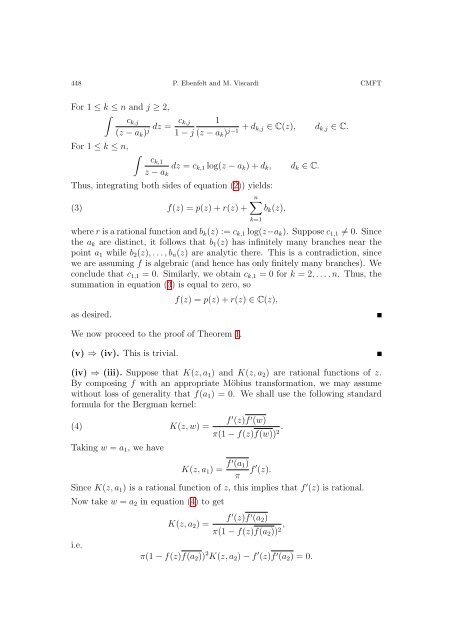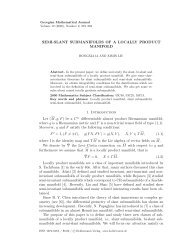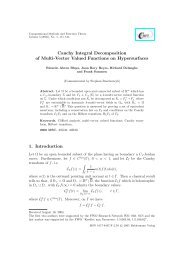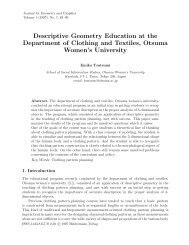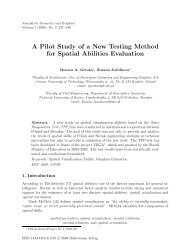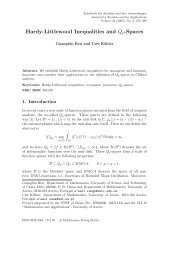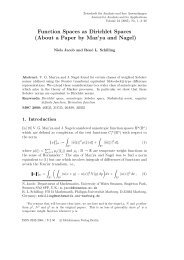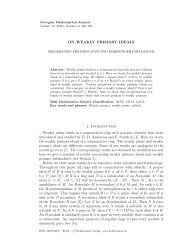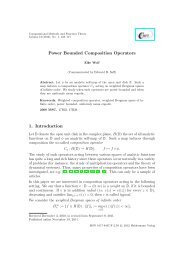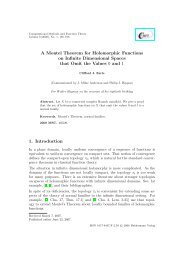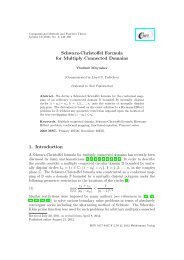On the Solution of the Dirichlet Problem with Rational Holomorphic ...
On the Solution of the Dirichlet Problem with Rational Holomorphic ...
On the Solution of the Dirichlet Problem with Rational Holomorphic ...
Create successful ePaper yourself
Turn your PDF publications into a flip-book with our unique Google optimized e-Paper software.
448 P. Ebenfelt and M. Viscardi CMFT<br />
For 1 ≤ k ≤ n and j ≥ 2,<br />
∫<br />
c k,j<br />
(z − a k ) dz = c k,j 1<br />
j 1 − j (z − a k ) + d j−1 k,j ∈ C(z), d k,j ∈ C.<br />
For 1 ≤ k ≤ n, ∫<br />
c k,1<br />
z − a k<br />
dz = c k,1 log(z − a k ) + d k , d k ∈ C.<br />
Thus, integrating both sides <strong>of</strong> equation (2)) yields:<br />
n∑<br />
(3) f(z) = p(z) + r(z) + b k (z),<br />
where r is a rational function and b k (z) := c k,1 log(z−a k ). Suppose c 1,1 ≠ 0. Since<br />
<strong>the</strong> a k are distinct, it follows that b 1 (z) has infinitely many branches near <strong>the</strong><br />
point a 1 while b 2 (z), . . . , b n (z) are analytic <strong>the</strong>re. This is a contradiction, since<br />
we are assuming f is algebraic (and hence has only finitely many branches). We<br />
conclude that c 1,1 = 0. Similarly, we obtain c k,1 = 0 for k = 2, . . . , n. Thus, <strong>the</strong><br />
summation in equation (3) is equal to zero, so<br />
as desired.<br />
k=1<br />
f(z) = p(z) + r(z) ∈ C(z),<br />
We now proceed to <strong>the</strong> pro<strong>of</strong> <strong>of</strong> Theorem 1.<br />
(v) ⇒ (iv). This is trivial.<br />
(iv) ⇒ (iii). Suppose that K(z, a 1 ) and K(z, a 2 ) are rational functions <strong>of</strong> z.<br />
By composing f <strong>with</strong> an appropriate Möbius transformation, we may assume<br />
<strong>with</strong>out loss <strong>of</strong> generality that f(a 1 ) = 0. We shall use <strong>the</strong> following standard<br />
formula for <strong>the</strong> Bergman kernel:<br />
(4) K(z, w) =<br />
Taking w = a 1 , we have<br />
f ′ (z)f ′ (w)<br />
π(1 − f(z)f(w)) 2 .<br />
K(z, a 1 ) = f ′ (a 1 )<br />
π<br />
f ′ (z).<br />
Since K(z, a 1 ) is a rational function <strong>of</strong> z, this implies that f ′ (z) is rational.<br />
Now take w = a 2 in equation (4) to get<br />
i.e.<br />
K(z, a 2 ) =<br />
f ′ (z)f ′ (a 2 )<br />
π(1 − f(z)f(a 2 )) 2 ,<br />
π(1 − f(z)f(a 2 )) 2 K(z, a 2 ) − f ′ (z)f ′ (a 2 ) = 0.


